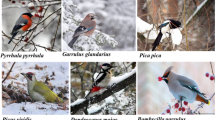Abstract
The yeast number and species diversity in feces of pigeons (Columba livia) were studied in various locations of the city of Moscow: parks, playgrounds and school grounds. The total number and species composition of yeasts in feces depended on the isolation temperature. The average yeast number at a cultivation temperature of 25 °C was 3.2 × 105 CFU/g, at 37 °C–2.5 × 106 CFU/g. At 37 °C, the number of yeasts was higher due to a more abundant growth of pathogenic and opportunistic yeast species. In total, 13 species of yeasts were isolated from feces: eight ascomycetes and five basidiomycetes. The study revealed high values of relative abundance and frequency of occurrence of pathogenic species Candida albicans and opportunistic yeasts, i.e. Diutina catenulata, Millerozyma farinosa, Pichia kudriavzevii, and Trichosporon asahii. Pigeon feces were found to present a constant source of “infection” of the urban environment with yeast species that are hazardous to human health, especially for immunosuppressive individuals.


Similar content being viewed by others
Data Availability
The datasets generated during the current study are available from the corresponding author on the request.
References
Filiú WF, Wanke B, Agüena SM et al (2002) Avian habitats as sources of Cryptococcus neoformans in the city of Campo Grande, Mato Grosso do Sul, Brazil. Rev Soc Bras Med Trop 35:591–595
Krcmery V, Barnes AJ (2002) Non-albicans Candida spp. causing fungaemia: pathogenicity and antifungal resistance. J Hosp Infect 50:243–260
Cafarchia C, Romito D, Iatta R (2006) Role of birds of prey as carriers and spreaders of Cryptococcus neoformans and other zoonotic yeasts. Med Mycol 44:485–492
Costa AK, Sidrim JC, Cordeiro RA et al (2010) Urban pigeons (Columba livia) as a potential source of pathogenic yeasts: a focus on antifungal susceptibility of Cryptococcus strains in Northeast Brazil. Mycopathologia 169:207–213
Dynowska M, Wojczulanis-Jakubas K, Pacynska J et al (2013) Potentially pathogenic yeast isolated from the throat and cloacae of an Arctic colonial seabird: the little auk (Alle alle). Polar Biol 36:343–348
Meissner W, Dynowska M, Goralska K, Rzyska H (2015) Mallards (Anas platyrhynchos) staying in urban environments have higher levels of microfungi biota diversity than do birds from nonurban areas. Fungal Ecol 17:164–169
Medina IR, Fuentes LR, Arteaga MB et al (2017) Pigeons and their droppings as reservoirs of Candida and other zoonotic yeasts. Rev Iberoam Micol 34:211–214
Moschetti G, Alfonzo A, Francesca N (2017) Yeasts in birds. In: Buzzini P, Lachance MA, Yurkov A (eds) Yeasts in natural ecosystems: diversity. Springer, Cham, pp 435–454
Glushakova AM, Kachalkin AV (2017) Endophytic yeasts in Malus domestica and Pyrus communis fruits under anthropogenic impact. Microbiology (Russian) 86:128–135
Glushakova AM, Kachalkin AV, Zheltikova TM, Chernov IY (2015) Yeasts associated with wind-pollinated plants—leading pollen allergens in Central Russia. Microbiology (Russian) 84:722–725
Tepeeva AN, Glushakova AM, Kachalkin AV (2018) Yeast communities of the Moscow city soils. Microbiology 87:407–415
Bosak IA (2009) Isolation and characteristic of Cryptococcus neoformans isolates in Saint Petersburg environmental, Saint Petersburg, Russia. Problemy Medicinskoj Mikologii 11:43–46
Antley PP, Hazen KC (1988) Role of yeast cell growth temperature on Candida albicans virulence in mice. Infect Immun 56:2884–2890
Kurtzman CP, Fell JW, Boekhout T (eds) (2011) The yeasts, a taxonomic study, 5th edn. Elsevier, Amsterdam, p 2080
Chae HS, Jang GE, Kim NH et al (2012) Classification of Cryptococcus neoformans and yeast-like fungus isolates from pigeon droppings by colony phenotyping and ITS genotyping and their seasonal variations in Korea. Avian Dis 56:58–64
Wu Y, Du P-C, Li W-G, Lu J-X (2012) Identification and molecular analysis of pathogenic yeasts in droppings of domestic pigeons in Beijing, China. Mycopathologia 174:203–214
Soltani M, Bayat M, Seyed J et al (2013) Isolation of Cryptococcus neoformans and other opportunistic fungi from pigeon droppings. J Res Med Sci 18:56–60
Krangvichain P, Niyomtham W, Prapasarakul N (2016) Occurrence and susceptibilities to disinfectants of Cryptococcus neoformans in fecal droppings from pigeons in Bangkok, Thailand. J Vet Med Sci 78:391–396
Obukhova NYu (2011) Dynamics of balanced polymorphism morphs in blue rock pigeon (Columba livia) from Moscow. Russ J Genet 47:95–102
Chernov IYu, Glushakova AM, Kachalkin AV (2013) Annotated list of yeast species of the Moscow region. Mikol Fitopatol 47:103–115
Lugarini C, Goebel CS, Condas LAZ et al (2008) Cryptococcus neoformans isolated from Passerine and Psittacine bird excreta in the State of Parana Brazil. Mycopathologia 166:61–69
Cogliati M (2013) Global molecular epidemiology of Cryptococcus neoformans and Cryptococcus gattii: an atlas of the molecular types. Scientifica. https://doi.org/10.1155/2013/675213
Pinto LM, Bezerra-Neto FA, Medeiros MAP et al (2019) Candida species isolated from pigeon (Columbia livia) droppings may express virulence factors and resistance to azoles. Vet Microbiol 235:43–52
Glushakova AM, Kachalkin AV, Akhapkina IG (2017) The monitoring of sensitivity of natural strains and clinical isolates of yeast fungi to antimycotics. Klin Lab Diagn (in Russian) 62:296–300
Acknowledgements
The identification of yeast strains in pigeon feces from parks was carried out as a part of the research project funding by the Russian Science Foundation (Grant No. 19-74-10002) to assess the role of pigeons in pathogen contamination of fruit plants.
Author information
Authors and Affiliations
Contributions
AMG Conceptualization, Data curation, Investigation, Resources, Writing—original draft, Writing—review & editing. ENR, Data curation, Investigation, Resources. AVK, Conceptualization, Data curation, Formal analysis, Writing—original draft, Writing—review & editing.
Corresponding author
Ethics declarations
Conflict of interest
The authors declare that there are no conflict of interest.
Additional information
Publisher's Note
Springer Nature remains neutral with regard to jurisdictional claims in published maps and institutional affiliations.
Rights and permissions
About this article
Cite this article
Glushakova, A.M., Rodionova, E.N. & Kachalkin, A.V. Yeasts in Feces of Pigeons (Columba livia) in the City of Moscow. Curr Microbiol 78, 238–243 (2021). https://doi.org/10.1007/s00284-020-02251-5
Received:
Accepted:
Published:
Issue Date:
DOI: https://doi.org/10.1007/s00284-020-02251-5




